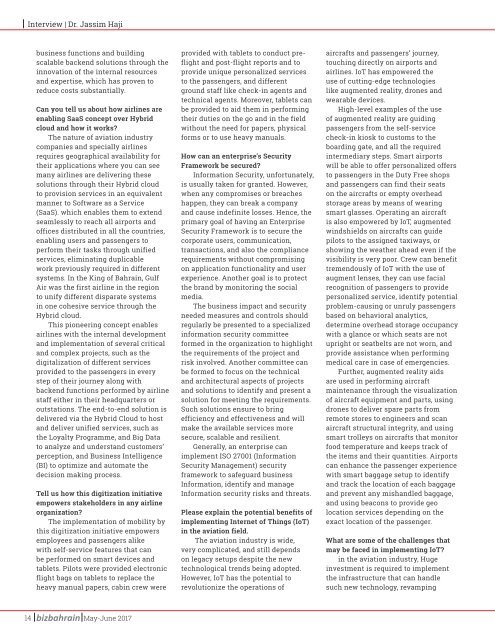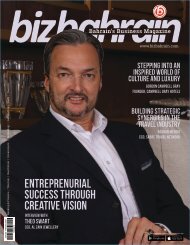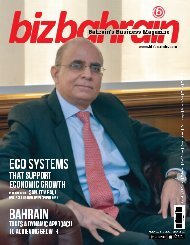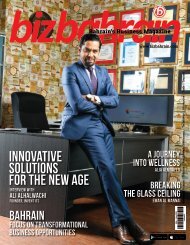BizBahrain May-June 2017
You also want an ePaper? Increase the reach of your titles
YUMPU automatically turns print PDFs into web optimized ePapers that Google loves.
Interview | Dr. Jassim Haji<br />
business functions and building<br />
scalable backend solutions through the<br />
innovation of the internal resources<br />
and expertise, which has proven to<br />
reduce costs substantially.<br />
Can you tell us about how airlines are<br />
enabling SaaS concept over Hybrid<br />
cloud and how it works?<br />
The nature of aviation industry<br />
companies and specially airlines<br />
requires geographical availability for<br />
their applications where you can see<br />
many airlines are delivering these<br />
solutions through their Hybrid cloud<br />
to provision services in an equivalent<br />
manner to Software as a Service<br />
(SaaS). which enables them to extend<br />
seamlessly to reach all airports and<br />
offices distributed in all the countries,<br />
enabling users and passengers to<br />
perform their tasks through unified<br />
services, eliminating duplicable<br />
work previously required in different<br />
systems. In the King of Bahrain, Gulf<br />
Air was the first airline in the region<br />
to unify different disparate systems<br />
in one cohesive service through the<br />
Hybrid cloud.<br />
This pioneering concept enables<br />
airlines with the internal development<br />
and implementation of several critical<br />
and complex projects, such as the<br />
digitalization of different services<br />
provided to the passengers in every<br />
step of their journey along with<br />
backend functions performed by airline<br />
staff either in their headquarters or<br />
outstations. The end-to-end solution is<br />
delivered via the Hybrid Cloud to host<br />
and deliver unified services, such as<br />
the Loyalty Programme, and Big Data<br />
to analyze and understand customers’<br />
perception, and Business Intelligence<br />
(BI) to optimize and automate the<br />
decision making process.<br />
Tell us how this digitization initiative<br />
empowers stakeholders in any airline<br />
organization?<br />
The implementation of mobility by<br />
this digitization initiative empowers<br />
employees and passengers alike<br />
with self-service features that can<br />
be performed on smart devices and<br />
tablets. Pilots were provided electronic<br />
flight bags on tablets to replace the<br />
heavy manual papers, cabin crew were<br />
provided with tablets to conduct preflight<br />
and post-flight reports and to<br />
provide unique personalized services<br />
to the passengers, and different<br />
ground staff like check-in agents and<br />
technical agents. Moreover, tablets can<br />
be provided to aid them in performing<br />
their duties on the go and in the field<br />
without the need for papers, physical<br />
forms or to use heavy manuals.<br />
How can an enterprise’s Security<br />
Framework be secured?<br />
Information Security, unfortunately,<br />
is usually taken for granted. However,<br />
when any compromises or breaches<br />
happen, they can break a company<br />
and cause indefinite losses. Hence, the<br />
primary goal of having an Enterprise<br />
Security Framework is to secure the<br />
corporate users, communication,<br />
transactions, and also the compliance<br />
requirements without compromising<br />
on application functionality and user<br />
experience. Another goal is to protect<br />
the brand by monitoring the social<br />
media.<br />
The business impact and security<br />
needed measures and controls should<br />
regularly be presented to a specialized<br />
information security committee<br />
formed in the organization to highlight<br />
the requirements of the project and<br />
risk involved. Another committee can<br />
be formed to focus on the technical<br />
and architectural aspects of projects<br />
and solutions to identify and present a<br />
solution for meeting the requirements.<br />
Such solutions ensure to bring<br />
efficiency and effectiveness and will<br />
make the available services more<br />
secure, scalable and resilient.<br />
Generally, an enterprise can<br />
implement ISO 27001 (Information<br />
Security Management) security<br />
framework to safeguard business<br />
Information, identify and manage<br />
Information security risks and threats.<br />
Please explain the potential benefits of<br />
implementing Internet of Things (IoT)<br />
in the aviation field.<br />
The aviation industry is wide,<br />
very complicated, and still depends<br />
on legacy setups despite the new<br />
technological trends being adopted.<br />
However, IoT has the potential to<br />
revolutionize the operations of<br />
aircrafts and passengers’ journey,<br />
touching directly on airports and<br />
airlines. IoT has empowered the<br />
use of cutting-edge technologies<br />
like augmented reality, drones and<br />
wearable devices.<br />
High-level examples of the use<br />
of augmented reality are guiding<br />
passengers from the self-service<br />
check-in kiosk to customs to the<br />
boarding gate, and all the required<br />
intermediary steps. Smart airports<br />
will be able to offer personalized offers<br />
to passengers in the Duty Free shops<br />
and passengers can find their seats<br />
on the aircrafts or empty overhead<br />
storage areas by means of wearing<br />
smart glasses. Operating an aircraft<br />
is also empowered by IoT, augmented<br />
windshields on aircrafts can guide<br />
pilots to the assigned taxiways, or<br />
showing the weather ahead even if the<br />
visibility is very poor. Crew can benefit<br />
tremendously of IoT with the use of<br />
augment lenses, they can use facial<br />
recognition of passengers to provide<br />
personalized service, identify potential<br />
problem-causing or unruly passengers<br />
based on behavioral analytics,<br />
determine overhead storage occupancy<br />
with a glance or which seats are not<br />
upright or seatbelts are not worn, and<br />
provide assistance when performing<br />
medical care in case of emergencies.<br />
Further, augmented reality aids<br />
are used in performing aircraft<br />
maintenance through the visualization<br />
of aircraft equipment and parts, using<br />
drones to deliver spare parts from<br />
remote stores to engineers and scan<br />
aircraft structural integrity, and using<br />
smart trolleys on aircrafts that monitor<br />
food temperature and keeps track of<br />
the items and their quantities. Airports<br />
can enhance the passenger experience<br />
with smart baggage setup to identify<br />
and track the location of each baggage<br />
and prevent any mishandled baggage,<br />
and using beacons to provide geo<br />
location services depending on the<br />
exact location of the passenger.<br />
What are some of the challenges that<br />
may be faced in implementing IoT?<br />
in the aviation industry, Huge<br />
investment is required to implement<br />
the infrastructure that can handle<br />
such new technology, revamping<br />
14 <strong>May</strong>-<strong>June</strong> <strong>2017</strong>

















